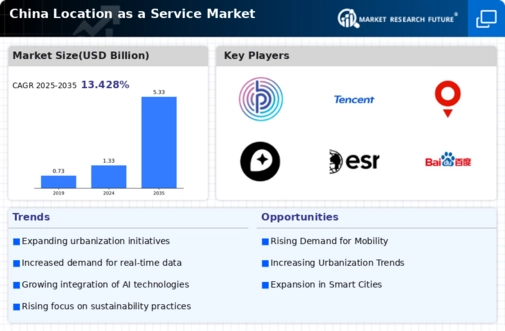Rising Demand for Real-Time Data
The location as-a-service market in China experiences a notable surge in demand for real-time data analytics. Businesses across various sectors, including retail and logistics, increasingly rely on accurate location data to enhance operational efficiency. The integration of real-time data allows companies to optimize supply chains, improve customer experiences, and make informed decisions. According to recent estimates, the market for real-time data analytics in China is projected to grow at a CAGR of approximately 25% over the next five years. This trend indicates a robust appetite for location-based services, driving the growth of the location as-a-service market. As organizations seek to leverage data for competitive advantage, the demand for innovative solutions in this industry is likely to intensify.
Government Initiatives and Support
Government initiatives play a pivotal role in shaping the location as-a-service market in China. The Chinese government has been actively promoting the development of smart infrastructure and digital economy initiatives. Policies aimed at enhancing urban planning and transportation systems are fostering an environment conducive to the growth of location-based services. For instance, the implementation of the National Spatial Planning Policy encourages the integration of geographic information systems (GIS) in urban development. This support is expected to propel the location as-a-service market, as businesses align their strategies with government objectives. Furthermore, funding and incentives for technology adoption are likely to stimulate innovation within the industry, creating a favorable landscape for growth.
Increased Urbanization and Mobility
China's rapid urbanization is a significant driver of the location as-a-service market. With over 60% of the population now residing in urban areas, the demand for efficient transportation and navigation solutions has escalated. Urban dwellers increasingly seek services that facilitate mobility, such as ride-hailing and public transport applications. The location as-a-service market is poised to benefit from this trend, as companies develop solutions that cater to the needs of urban populations. Moreover, the rise in mobility services is projected to contribute to a market growth rate of around 20% annually. This dynamic environment presents opportunities for businesses to innovate and expand their offerings in the location as-a-service market.
Growing E-commerce and Delivery Services
The expansion of e-commerce and delivery services in China is a critical driver of the location as-a-service market. As online shopping continues to gain traction, businesses are increasingly reliant on location-based services to optimize delivery routes and enhance customer satisfaction. The e-commerce sector in China is projected to surpass $2 trillion by 2025, creating a substantial demand for efficient logistics solutions. Companies are adopting location as-a-service offerings to streamline operations and improve last-mile delivery efficiency. This trend suggests that the location as-a-service market will experience robust growth, as businesses seek to capitalize on the booming e-commerce landscape and the associated logistical challenges.
Technological Advancements in GPS and Mapping
Technological advancements in GPS and mapping technologies are transforming the location as-a-service market in China. Innovations in satellite technology and mobile applications have enhanced the accuracy and reliability of location-based services. As GPS technology continues to evolve, businesses are increasingly able to provide precise location data to consumers. This improvement is particularly relevant in sectors such as logistics, where accurate tracking of shipments is crucial. The market for GPS technology in China is expected to reach approximately $10 billion by 2026, indicating a strong growth trajectory. Consequently, the location as-a-service market is likely to benefit from these advancements, as companies leverage improved technologies to enhance their service offerings.

















Leave a Comment